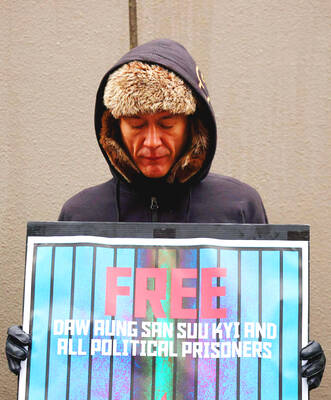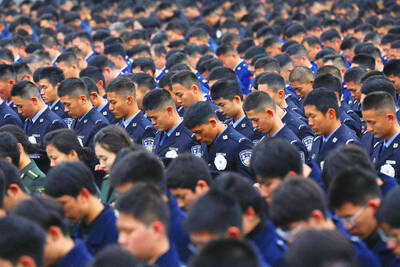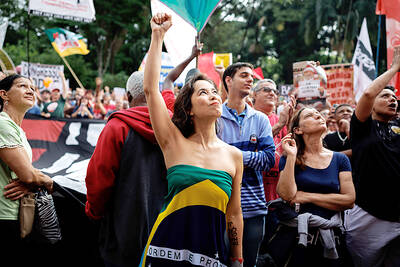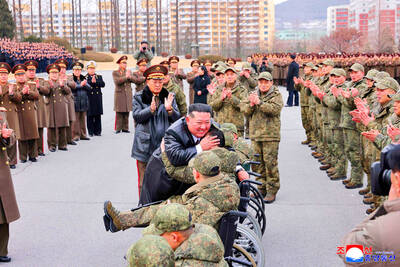Filipinos reaped praise worldwide for using peaceful "people power" to oust dictator Ferdinand Marcos and restore democracy in 1986. But 15 years later, they were criticized for using the same tactics to force out President Joseph Estrada midway through the six-year term he won with the widest margin in Philippine history.
Filipinos head to the polls again today in a race seen as so close that millions of voters will likely be dissatisfied with the outcome. Some wonder whether the nation can accept the results without another "people power" revolt.
The hope is that Filipinos are now politically mature enough to accept the result and let the democratic institutions and legal system resolve any conflicts.
"For me, after the second one -- that's enough," said taxi driver Daniel Original, who was only 7 when Marcos was toppled. "If we have another one, it won't look good anymore."
Even though Estrada's ouster was legitimized by a Supreme Court ruling, critics say his fate should have been determined by an impeachment trial that stalled after opposition prosecutors walked out in a protest over the pro-Estrada Senate majority blocking crucial evidence.
Conditions in the Philippines do not inspire confidence that it will remain free of upheavals.
Shortly after Estrada exited through the back door, there was a foiled bid by tens of thousands of his supporters to storm the presidential palace to oust his successor, Gloria Macapagal Arroyo. A group of disgruntled military men staged a brief, failed mutiny last July.
Just days ahead of today's polling, the national security adviser claimed that opposition figures are already plotting to stir up trouble if they lose.
If Estrada had stayed in office, the election would have chosen his successor. Instead, it pits Arroyo against Fernando Poe Jr., an action film star and close friend of Estrada, with three other candidates given scant chance of success.
Political commentator Benito Lim, a former Asian studies professor, traces the roots of mass protests to a failure by the nation's elite to solve the gripping social ills of poverty, corruption, an underdeveloped economy, sharply unequal distribution of wealth and lack of opportunities.
After decades of control by an ineffective upper class, Filipino "people power" emerged as a "tribal gathering to oust a person they hate," Lim said.
"It has never been a genuine revolution of a common desire to institute common programs addressing issues and problems of the republic," Lim said.
Arroyo's political adviser, Joey Rufino, said the first "people power" revolt -- called the "EDSA revolution" or "EDSA 1" after the Manila highway where it took place -- was staged against dictatorship. The second, dubbed "EDSA 2," took aim at "corruption and bad governance," Rufino said.
The 1986 revolt revived a political system -- modeled after that of former colonial power the US -- that prevailed before Marcos imposed martial law in 1972 and started his one-man rule. People took to the streets about two weeks after Marcos purportedly stole an election from opposition candidate Corazon Aquino, and she was swept to power.
Filipinos remember Rufino, now executive director of the ruling Lakas-CMD party, as the man caught by television cameras tearfully pleading with soldiers -- who had been sent by Marcos to quash the uprising -- to instead join the revolt.
Rufino said he's now "too old" for street protests and he hopes the "EDSA 2" movement will be the last.
"We can't keep on going to the streets every time we hate something in government. That would be mob rule or anarchy," he said.
His fear: "One day, everybody will just wish there was a leader that is a strongman. And, then everybody will lose their rights. Everybody will lose their freedoms because they abused them."

The Burmese junta has said that detained former leader Aung San Suu Kyi is “in good health,” a day after her son said he has received little information about the 80-year-old’s condition and fears she could die without him knowing. In an interview in Tokyo earlier this week, Kim Aris said he had not heard from his mother in years and believes she is being held incommunicado in the capital, Naypyidaw. Aung San Suu Kyi, a Nobel Peace Prize laureate, was detained after a 2021 military coup that ousted her elected civilian government and sparked a civil war. She is serving a

China yesterday held a low-key memorial ceremony for the 1937 Nanjing Massacre, with Chinese President Xi Jinping (習近平) not attending, despite a diplomatic crisis between Beijing and Tokyo over Taiwan. Beijing has raged at Tokyo since Japanese Prime Minister Sanae Takaichi last month said that a hypothetical Chinese attack on Taiwan could trigger a military response from Japan. China and Japan have long sparred over their painful history. China consistently reminds its people of the 1937 Nanjing Massacre, in which it says Japanese troops killed 300,000 people in what was then its capital. A post-World War II Allied tribunal put the death toll

‘NO AMNESTY’: Tens of thousands of people joined the rally against a bill that would slash the former president’s prison term; President Lula has said he would veto the bill Tens of thousands of Brazilians on Sunday demonstrated against a bill that advanced in Congress this week that would reduce the time former president Jair Bolsonaro spends behind bars following his sentence of more than 27 years for attempting a coup. Protests took place in the capital, Brasilia, and in other major cities across the nation, including Sao Paulo, Florianopolis, Salvador and Recife. On Copacabana’s boardwalk in Rio de Janeiro, crowds composed of left-wing voters chanted “No amnesty” and “Out with Hugo Motta,” a reference to the speaker of the lower house, which approved the bill on Wednesday last week. It is

FALLEN: The nine soldiers who were killed while carrying out combat and engineering tasks in Russia were given the title of Hero of the Democratic People’s Republic of Korea North Korean leader Kim Jong-un attended a welcoming ceremony for an army engineering unit that had returned home after carrying out duties in Russia, North Korean state media KCNA reported on Saturday. In a speech carried by KCNA, Kim praised officers and soldiers of the 528th Regiment of Engineers of the Korean People’s Army (KPA) for “heroic” conduct and “mass heroism” in fulfilling orders issued by the ruling Workers’ Party of Korea during a 120-day overseas deployment. Video footage released by North Korea showed uniformed soldiers disembarking from an aircraft, Kim hugging a soldier seated in a wheelchair, and soldiers and officials